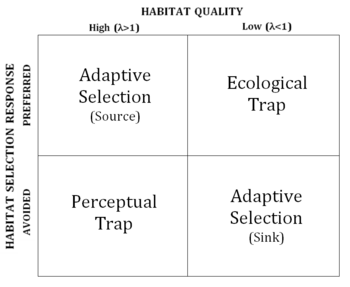Biology:Perceptual trap

A perceptual trap is an ecological scenario in which environmental change, typically anthropogenic, leads an organism to avoid an otherwise high-quality habitat. The concept is related to that of an ecological trap, in which environmental change causes preference towards a low-quality habitat.
History
In a 2004 article discussing source–sink dynamics, James Battin did not distinguish between high-quality habitats that are preferred or avoided, labelling both "sources."[2] The latter scenario, in which a high-quality habitat is avoided, was first recognised as an important phenomenon in 2007 by Gilroy and Sutherland,[3] who described them as "undervalued resources." The term "perceptual trap" was first proposed by Michael Patten and Jeffrey Kelly in a 2010 article.[1] Hans Van Dyck[4] argues that the term is misleading because perception is also a major component in other cases of trapping.
Description
Animals use discrete environmental cues to select habitat.[5] A perceptual trap occurs if change in an environmental cue leads an organism to avoid a high-quality habitat.[1] It differs, therefore, from simple habitat avoidance, which may be a correct decision given the habitat's quality.[1] The concept of a perceptual trap is related to that of an ecological trap, in which environmental change causes preference towards a low-quality habitat.[1] There is expected to be strong natural selection against ecological traps, but not necessarily against perceptual traps, as Allee effects may restrict a population’s ability to establish itself.[1]
Examples

To support the concept of a perceptual trap, Patten and Kelly[1] cited a study of the lesser prairie chicken (Tympanuchus pallidicinctus). The species' natural environment, shinnery oak grassland, is often treated with the herbicide tebuthiuron to increase grass cover for cattle grazing.[1] Herbicide treatment resulted in less shrub cover, a habitat cue that caused female lesser prairie-chickens to avoid the habitat in favour of untreated areas. However, females who nested in herbicide-treated areas achieved comparable nesting successes and clutch sizes to those in untreated areas.[1] Patten and Kelly suggest that the adverse effects of tebuthiuron treatment on nesting success are countered by various effects, such as greater nest concealment through increased grass cover.[1] Therefore, female birds are erroneously avoiding a high-quality habitat. Patten and Kelly[1] also cited as a possible perceptual trap the cases of the spotted towhee (Pipilo maculatus) and rufous-crowned sparrow (Aimophila ruficeps), which tend to avoid habitat fragments, even though birds nesting in habitat fragments achieve increased nesting success due to a reduction in snake predation.[6]
See also
References
- ↑ 1.00 1.01 1.02 1.03 1.04 1.05 1.06 1.07 1.08 1.09 1.10 1.11 Patten, M.A., and Kelly, J.F. (2010) "Habitat selection and the perceptual trap," Ecological Applications, 20: 2148–2156.
- ↑ Battin, J. (2004) "When good animals love bad habitats: ecological traps and the conservation of animal populations" (PDF), Conservation Biology, 18: 1482–1491
- ↑ Gilroy, J. J., and W. J. Sutherland. (2007) "Beyond ecological traps: perceptual errors and undervalued resources," Trends in Ecology and Evolution, 22: 351–356
- ↑ Van Dyck, H. (2012) "Changing organisms in rapidly changing anthropogenic landscapes: the significance of the ‘Umwelt’-concept and functional habitat for animal conservation," Evolutionary Applications, 5(2): : 144–153.
- ↑ Kristan, W. B. (2003) "The role of habitat selection behavior in population dynamics: source–sink systems and ecological traps," Oikos, 103: 457–468
- ↑ Patten, M. A., and D. T. Bolger (2003) "Variation in top-down control of avian reproductive success across a fragmentation gradient", Oikos, 101:479–488
 |

